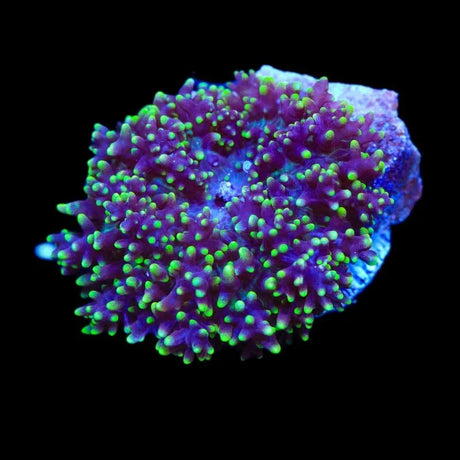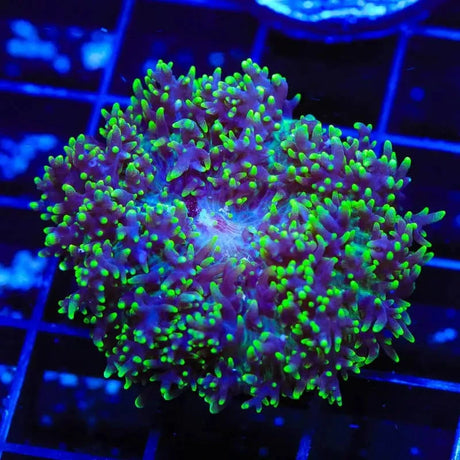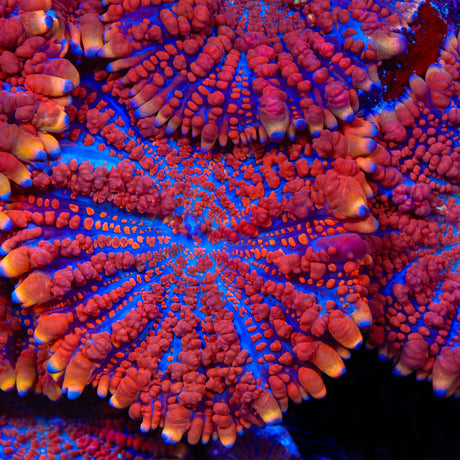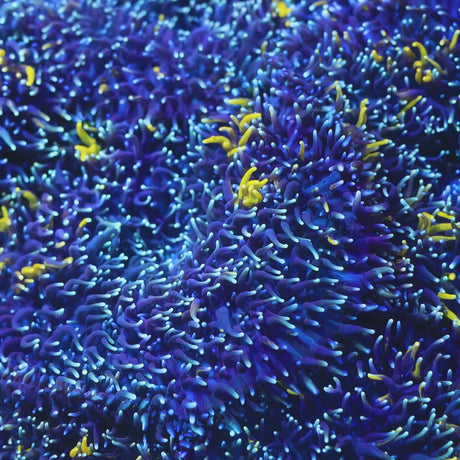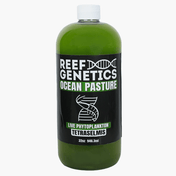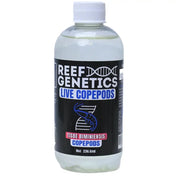Mushroom corals are one of the most beginner-friendly and adaptable soft corals you can keep in a reef aquarium. They lack a hard skeletal structure, which means they are less dependent on calcium, alkalinity, and magnesium compared to stony corals, and they are capable of thriving in a wider range of conditions.
At Top Shelf Aquatics, we aquaculture a wide variety of mushroom corals including Discosoma, Rhodactis, and Ricordea, each offering unique shapes, textures, and brilliant coloration. From smooth-capped species to bumpy, textured morphs, mushrooms come in nearly every color imaginable: deep reds, greens, blues, purples, and multicolor variations that shift and glow under aquarium lighting.
These corals appeal to both newcomers and seasoned reef keepers. Beginners appreciate their forgiving nature, while experienced hobbyists often seek out high-end collectible varieties such as bounce mushrooms, famous for their inflated vesicles and vibrant marbled colors. Some rarer bounce strains, like the OG Bounce, can command premium prices among collectors.
Whether you are looking to add a splash of color to shaded areas of your reef or searching for a coral that is as hardy as it is striking, mushroom corals offer the perfect balance of beauty, adaptability, and low-maintenance care.
Why Mushroom Corals Are Beginner-Friendly
Mushroom corals are often one of the first corals recommended to new reef keepers, and for good reason. They are incredibly adaptable and can thrive in a variety of aquarium setups, from ultra-clean, low-nutrient SPS systems to high-nutrient mixed reefs.
Unlike stony corals, mushrooms do not rely heavily on calcium or magnesium because they lack a rigid skeleton. This makes them less sensitive to fluctuations in these parameters and reduces the need for constant dosing. While they still benefit from overall stable water chemistry, they can tolerate small parameter swings that might stress other corals.
In fact, many mushrooms seem to prefer nutrient-rich environments. Systems with slightly elevated nitrates and phosphates often encourage faster growth and deeper, richer coloration. They can still adapt to cleaner water, but you may find their growth rate slows in ultra-low nutrient tanks.
Another reason they are so beginner-friendly is their ability to recover from stress. Even if a mushroom detaches from its base or shrinks due to a change in conditions, it will often reattach and bounce back with proper care. Their natural resilience means that mistakes, which are common when starting out, are less likely to result in permanent losses.
For new reef keepers looking for a hardy coral that grows quickly and rewards you with beautiful colors, mushrooms are one of the most forgiving and rewarding choices you can make.
Ideal Water Parameters
One of the reasons mushroom corals are so forgiving is their ability to adapt to a broad range of water conditions. While they can handle more variability than many corals, maintaining stable parameters will always promote better coloration, faster growth, and overall health.
Recommended Ranges for Mushroom Corals:
-
Salinity: 1.024–1.026
-
Temperature: 76–78°F (24–25.5°C)
-
pH: 8.0–8.4
-
Alkalinity: 8–9 dKH
-
Nitrates: 5–20 ppm
-
Phosphates: 0.03–0.1 ppm
Mushrooms tend to do well in systems with moderate nutrient levels. A small amount of nitrate and phosphate in the water supports their growth and helps maintain vibrant coloration. In ultra-clean systems, mushrooms may appear smaller and paler, so many reef keepers intentionally maintain slightly higher nutrient levels for them.
While calcium, alkalinity, and magnesium are not as critical for mushrooms as they are for hard corals, you should still keep them within standard reef parameters to support overall system stability.
Tip: Avoid large, sudden parameter swings. Even though mushrooms can recover from stress, consistent stability will help prevent detachment, shrinking, or loss of color.
Placement & Flow Requirements
Mushroom corals thrive when placed in areas that match their natural preferences for lighting and flow. In most cases, they will do best in the lower to middle sections of the aquarium, where conditions are more stable and light intensity is lower.
Lighting
Mushrooms prefer low to moderate light levels in the range of 50–150 PAR. Too much light can cause them to bleach or shrink, while too little may slow growth and dull coloration. If placing them in a brighter location, acclimate them slowly by starting in a shaded area and gradually moving them into more light over several weeks.
Flow
Low, indirect flow is ideal. Strong, direct currents can cause mushrooms to retract or even detach from their base. Gentle movement in the water helps prevent detritus from settling on them without damaging their delicate tissues.
Placement Tips
-
Position mushrooms on a stable surface where their foot can securely attach.
-
They often do well in shadier spots under overhangs or in corners where other corals may struggle.
-
If they are unhappy with their location, mushrooms can slowly “walk” across the rock to find a more suitable spot. They may even leave behind small pieces of tissue as they move, which can grow into new mushrooms.
-
Consider placing them on their own rock island if you want to limit spread. They can quickly overtake available space and crowd out neighboring corals.
Your goal with placement is to provide them a comfortable, low-stress environment right from the start. Once settled, mushrooms often remain in place for years — unless conditions change, in which case they will seek out a better location on their own.
Feeding Mushroom Corals
Mushroom corals are photosynthetic, meaning they gain much of their energy from the symbiotic zooxanthellae within their tissues. However, supplemental feeding can significantly improve growth, coloration, and overall health. While they can survive without target feeding, providing them with nutritious foods will help them thrive.
Feeding Benefits
-
Accelerates growth and encourages faster spread.
-
Enhances coloration, especially in high-end varieties like bounce mushrooms.
-
Provides additional nutrition in lower-light systems.
What to Feed
Mushrooms will accept a variety of foods:
-
Meaty foods: Mysis shrimp, brine shrimp, Calanus.
-
Powdered coral foods: Reef Roids, Benepets.
-
Pellet foods: Small LPS pellets such as Fauna Marin.
-
Liquid supplements: Products like AquaVitro Fuel for added nutrition.
Feeding Technique
At TSA, we often feed mushrooms using a fine-particle mixture that promotes strong growth and vibrant coloration. This mix typically includes Reef Roids, Benepets, our own cultured phytoplankton, and select amino acids to support coral tissue development and health.
To feed:
-
Turn off your flow before feeding.
-
Using a turkey baster or pipette, gently place the food mixture directly over the mushroom’s mouth.
-
Allow the coral time to fully engulf and consume the food before turning the flow back on.
Watching a mushroom feed is fascinating. They will often fold inward, much like a Venus flytrap, to trap food particles before slowly drawing them into their mouth.
Target feeding once or twice a week is enough for most systems. In higher-nutrient environments, you may choose to feed less frequently to avoid excess organics in the water.
Growth & Propagation
Mushroom corals are known for their ability to reproduce quickly, especially once they are settled in and thriving. In a stable, nutrient-rich system, it is common to see them multiply at a steady pace, gradually filling in available space.
How Mushrooms Reproduce
-
Pedal laceration: As a mushroom moves across the rock, it leaves behind small pieces of tissue from its foot. These fragments develop into new mushrooms over time.
-
Splitting: A single mushroom can divide into two, creating genetically identical clones.
-
Walking behavior: If a mushroom is unhappy with its location, it can slowly detach its foot and move to a more suitable spot. This movement often leaves behind tissue that will grow into new individuals.
Managing Growth
While their ability to reproduce makes them an attractive option for quickly filling in bare rock, it can also lead to overgrowth. Many reef keepers dedicate a specific “mushroom island” rock for them so they do not encroach on other corals. Once mushrooms spread across the main aquascape, it can be difficult to remove them without damaging surrounding tissue or rock.
Propagation in the Aquarium
If you wish to encourage propagation, placing mushrooms in lower-flow areas with stable nutrient levels will often result in faster reproduction. Conversely, if you need to slow their spread, reduce direct feeding and place them in areas where they have less surface area to colonize.
With a little planning, mushroom corals can be one of the most rewarding soft corals for creating colorful, living carpets in your reef aquarium.
Common Challenges & Troubleshooting
Although mushroom corals are hardy and adaptable, they can still show signs of stress if conditions are not to their liking. Understanding these warning signs and knowing how to respond will help you keep them healthy long-term.
Signs of Stress
-
Shrinking or closing up: Often caused by too much light, too much flow, or unstable parameters.
-
Paling or bleaching: Typically due to excessive light exposure.
-
Detachment from the base: Can occur when a mushroom is unhappy with lighting, flow, or placement.
-
Failure to expand: May indicate irritation from neighboring corals or poor water quality.
How to Respond
-
Adjust placement: Move the mushroom to a lower light or lower flow location.
-
Check parameters: Ensure salinity, temperature, and nutrient levels are within recommended ranges.
-
Reduce stress: Avoid sudden changes in lighting intensity or water chemistry.
Reattachment Technique
If a mushroom detaches, you can help it reattach in a controlled setting. At TSA, we often place loose mushrooms in a small, reef-safe container or “mushroom box” with rubble rock at the bottom. This keeps them in a low-flow area where they can safely attach their foot to a surface without being blown around by currents. Once attached, the mushroom can be moved back into the main display.
With a little patience, most mushrooms will recover from stress and return to their normal, expanded appearance.
Final Tips for Long-Term Success
Mushroom corals are one of the most rewarding additions you can make to a reef aquarium. Their ability to thrive in a variety of conditions, combined with their incredible range of colors and patterns, makes them suitable for both beginners and experienced hobbyists.
For long-term success:
-
Start with stable parameters and maintain them consistently. Even though mushrooms are forgiving, they still appreciate a stable environment.
-
Choose the right placement in lower to middle areas of the tank with low to moderate light and gentle, indirect flow.
-
Feed strategically to encourage strong growth and vibrant coloration, but avoid overfeeding in nutrient-rich systems.
-
Plan for growth by giving mushrooms their own rock or dedicated space to prevent them from overtaking other corals.
-
Monitor regularly for signs of stress and be ready to adjust placement or conditions if needed.
Whether you are creating a colorful “mushroom garden” or adding a few pieces to fill in shaded areas, these corals will reward you with consistent growth, fascinating behavior, and brilliant displays of color for years to come.




